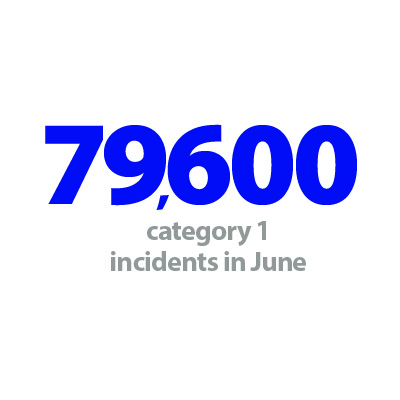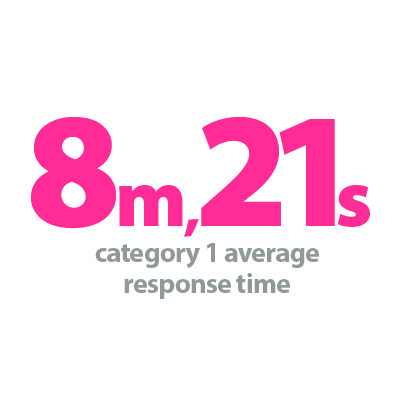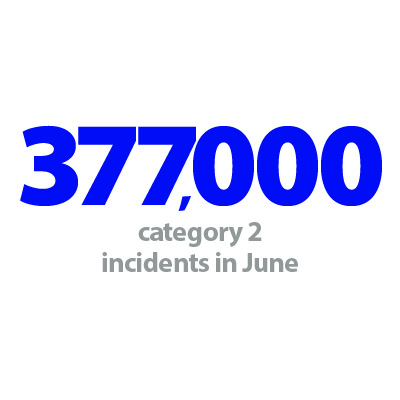


Demand and activity
Urgent and emergency care pathways have been experiencing sustained high levels of demand. The ambulance service answered over 800,000 calls in June and has taken over 4.7 million calls since the start of 2024.
Ambulance demand for life-threatening injuries and illnesses (category 1) has been unwaveringly high for some time. Prior to the Covid-19 pandemic, in the period from August 2017 (when the data begins) to February 2020, category 1 incidents only went above 70,000 once (December 2019). There were on average 54,500 category 1 incidents each month in this period.
Since June 2021, monthly category 1 incidents have only dropped below 70,000 three times and for the last 12 months they’ve only dropped below 75,000 once. Demand for the most serious life-threatening conditions shows no signs of stopping. After the highest May on record in 2024, demand for category 1 incidents (life-threatening injuries and illnesses) remains high at 79,600, a record for June data. In fact, the average number of category 1 incidents since the start of 2024 is 79,500 – which is 25,000 more on average per month than the period before the Covid-19 pandemic.
Since December 2018, monthly callouts for category 2 (emergency calls) incidents have been above 320,000 every month apart from November 2023, which shows the consistent high levels of demand the service faces. In the last 12 months, there have been at least 365,000 category 2 incidents each month, with highs of over 410,000 in December 2023. In June 2024, there were 377,000 category 2 incidents.
Response times
The national ambulance response time targets are 7 minutes for category 1 incidents and 18 minutes for category 2 incidents. However, as part of the plan to recover urgent and emergency care, NHS England adjusted the category 2 target to 30 minutes.
The last time the category 1 response time target was met was in April 2021 during the Covid-19 period. The last time the category 2 recovery target of 30 minutes was met was in April 2023, when it was first introduced in the 2023/24 planning guidance.
After falling to a 12-month low of 8 minutes 10 seconds for category 1 and 30 minutes 22 seconds for category 2 in April 2024, response times have deteriorated over the last two months, reaching 8 minutes 21 seconds for category 1 and 34 minutes 38 seconds for category 2 in June 2024. None of the regions met the 7-minute category 1 target this month, however, five out of the 10 ambulance trusts met the 30-minute target (the North West – 26 minutes 53 seconds; North East – 27 minutes 11 seconds; West Midlands – 28 minutes 30 seconds; South Central – 29 minutes 50 seconds; the South East Coast – 30 minutes).
All ambulance trusts are working hard with acute trusts and other health and care system partners to reduce handover delays and improve average response times, in the face of record high demand. There are examples of where local systems are working well and improvements across pathways are being made. Small improvements are borne out in the national level data – compared to June 2023 category 1 times are 20 seconds faster and category 2 times have improved by over 2 minutes.
Ambulance trust leaders and NHS England carried out thorough academic evaluation research to set stretching but realistic targets when the ambulance standards were renewed in 2017. As figure 3 shows, the category 1 standard was met, following focused work on the categorisation and handling of calls from the sector. However, the context has changed significantly for ambulance trusts since 2017.
The unrelenting and sustained high levels of demand is a stark mismatch to current levels of fleet, workforce and funding. This ongoing and challenging context suggests that improving ambulance performance should also be a key priority for the new government. In the context of national performance standards, we would like to see national stakeholders work closely with the ambulance sector and system partners to revisit the recovery plans and milestones, considering what support the sector needs to deliver improvements.
Ambulance response times for category 1 incidents
